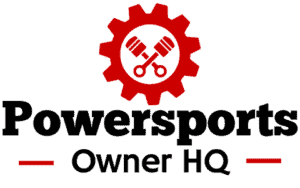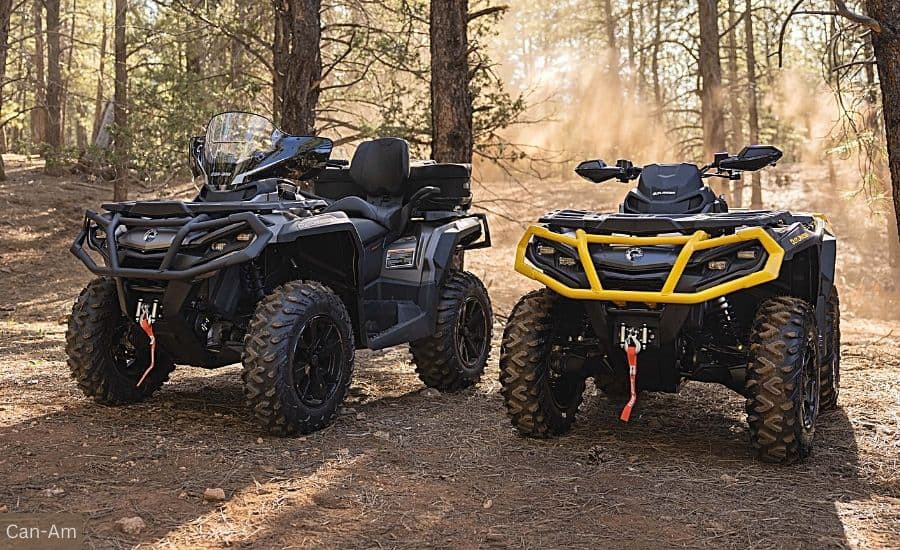All-terrain vehicles, commonly referred to as four-wheelers or quads, offer a wide range of horsepower, ranging from as little as 3 to as much as 90 horsepower.
Depending on the size of the ATV, engine displacement, and intended rider.
Because of this, it can be challenging to figure out ATV horsepower, especially when you factor in that many ATV manufacturers don’t list the horsepower of their models.
So to help clear up any confusion around ATV horsepower, we created this comprehensive guide that provides the horsepower of 18 popular models as well as a complete breakdown of ATV horsepower including:
- Understanding ATV Horsepower
- Average ATV Horsepower Ranges
- Choosing the Correct ATV Horsepower Based on Your Needs & Skill
- Average Horsepower Ratings Based on ATV Engine Size
- Pros & Cons of Different ATV Horsepower Levels
- Best Bolt-On Ways to Boost ATV Horsepower
Popular ATV Models (Lowest to Highest Horsepower)
| Make/Model | Horsepower (Approximate) | Engine Displacement | Intended Rider |
|---|---|---|---|
| 1. YAMAHA YFZ 50 | 3 HP | 49cc | Youth |
| 2. Kawasaki KFX 50 | 3 HP | 49cc | Youth |
| 3. Honda TRX90X | 5 HP | 86cc | Youth |
| 4. YAMAHA GRIZZLY 90 | 6 HP | 99cc | Youth |
| 5. Can-Am DS 70 | 8 HP | 77cc | Youth |
| 6. Honda FourTrax Recon | 16 HP | 229cc | Teens/Small Adults |
| 7. Honda 300EX | 18.5 HP | 282cc | Teens/Small Adults |
| 8. Kawasaki Brute Force 300 | 22 HP | 271cc | Teens/Small Adults |
| 9. Suzuki King Quad 300 | 25 HP | 280cc | Teens/Small Adults |
| 10. Yamaha Grizzly 450 | 28 HP | 421cc | Adults |
| 11. Suzuki King Quad 450 | 37 HP | 454cc | Adults |
| 12. Polaris Sportsman 570 | 44 HP | 567cc | Adults |
| 13. Arctic Cat Alterra 600 SE | 45 HP | 600cc | Adults |
| 14. CFMoto CForce 800 XC | 62 HP | 800cc | Adults |
| 15. Polaris Sportsman 850 | 78 HP | 850cc | Adults |
| 16. CFMoto CForce 1000 Overland | 79 HP | 963cc | Adults |
| 17. Polaris Sportsman XP 1000 | 89 HP | 952cc | Adults |
| 18. Can-Am Renegade 1000 | 91 HP | 976cc | Adults |
Understanding ATV Horsepower
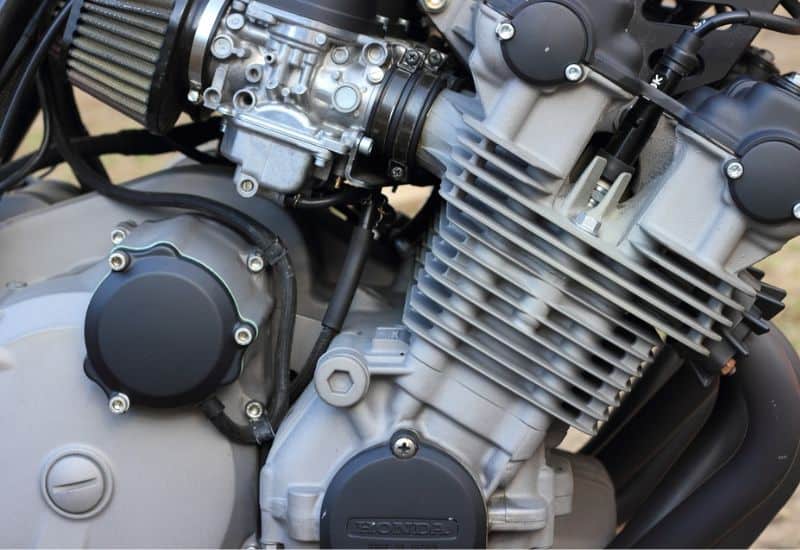
Horsepower is a measure of the work done by an engine, referring to its overall strength and capability.
The more horsepower an ATV has, the more torque and power it can produce for trail riding, hills, towing, and hauling.
Plus, it also impacts the vehicle’s top speed, as higher horsepower quads can generally reach higher top speeds.
Many factors contribute to how much horsepower an ATV engine can put out, including:
- Engine Displacement in cc (cubic centimeters)
- Engine Design and Technology, Like Fuel Injection vs. Carburetion
- Efficiency of Air Intake and Exhaust Systems
- Inclusion of a Turbocharger
For a better understanding of what contributes to ATV horsepower, let’s take a look at some basic concepts about engines and their power output.
Torque vs. Horsepower
While related, torque and horsepower measure different aspects of an engine’s power.
As you can see below:
- Torque: The twisting force an engine exerts on the drivetrain, measured in pound-feet. Important for towing/hauling and initial acceleration.
- Horsepower: The rate at which an engine can sustain torque. Governs maintained speed, climbing ability, and overall performance.
At lower RPMs, a four-wheeler engine tends to make peak torque.
Horsepower then increases as RPMs climb and the engine can apply that torque for longer durations.
Understanding both metrics is key to choosing the right engine for your needs.
Two-Stroke vs. Four-Stroke ATV Engines
ATVs can be fueled by either two-stroke or four-stroke engines.
- Two-stroke Engines: Generate more horsepower for their size since power strokes occur faster. They are less complex, and accelerate rapidly but lack sustainability at high RPMs.
- Four-stroke Engines: Requires greater complexity but produces power with better efficiency and sustainability for mid-range and high-rpms.
Most adult ATVs today use four-stroke engines, as the benefits of efficiency, smooth power delivery, and adequate rpms, outweigh the spike in power from smaller two-stroke engines.
Average ATV Horsepower Ranges

Depending on engine size, design, and intended rider, ATV horsepower can vary greatly.
Youth ATV Models: 3-25 HP
Youth ATV models typically offer between 3 to 25 horsepower, depending on the engine and its displacement.
Kid ATVs generally feature engine displacements from 50 to 100cc, while teen and young adult ATVs typically have engine displacements between 100 and 300cc.
However, the 100 to 300cc engine size can also be a good fit for smaller adults and new riders as well.
These models generally have engines tuned for reduced torque and horsepower appropriate for young, lightweight riders.
Entry-Level Adult ATVs: 25-50 HP
Entry-level adult ATVs typically offer 25 to 50 horsepower, depending on the engine and its displacement.
Offering displacements from 300 to 500cc the engines in these models offer moderate levels of torque and horsepower.
Providing more than enough horsepower and torque for general trail riding and light-duty work.
These ATVs cater to riders who want a machine that packs enough punch to make the ride exciting, but not so much that it becomes intimidating or hard to handle.
Mid-Size ATVs: 50-75 HP
Mid-size ATVs generally offer 50 to 75 horsepower with engine displacements ranging from 500 and 700cc.
These models offer more aggressive acceleration and power and are best suited for aggressive trail riding, medium-load hauling, and towing light trailers or equipment.
This class of ATVs steps up to meet the demands of riders seeking more thrill and utility from their machines.
With increased horsepower, these ATVs provide a noticeable uptick in performance that can be felt whether you’re accelerating on a straightaway or climbing a steep hill.
High-Performance ATVs: 75-90+ HP
The largest and most powerful ATVs offer 70 to 90 horsepower with engine displacement between 700 and 1000cc.
Offering maximum torque and horsepower, these machines provide extreme acceleration, high top speeds, and impressive hill climbs.
Making them best suited to expert riders and heavy workloads.
Choosing the Correct ATV Horsepower Based on Your Needs & Skill
It’s easy to get charmed by ATV manufacturers and marketers touting bigger and more powerful four-wheelers.
Or caught up in the one-upmanship of buying the fastest and most powerful ATV.
However, bigger and more powerful isn’t always better, depending on your size and intended use.
In fact, one of the quickest ways to get yourself into trouble is to buy an ATV with an engine size and horsepower rating beyond your skill level.
Because of this, it’s important to consider several factors when deciding how much horsepower you need.
Factors to Consider When Deciding on ATV Horsepower
- Rider Size/Weight – Heavier riders require more horsepower to achieve adequate acceleration, top speeds, and hill climbing. For example, a 200-pound adult needs more power than a 130-pound teen.
- Solo or Tanden Riding – Directly correlated to rider size and weight is the number of riders. If you plan to do a lot of tandem riding you may want to bump up the horsepower to handle the added weight of the extra rider.
- Type of Terrain – Rugged mountains, deep mud and stream crossings, dunes, and wide-open spaces for high-speed trail riding call for ample horsepower. Tight and technical wooded trails with little incline won’t benefit as much. Think about the landscape where you will ride most.
- Towing/Hauling Use – Hauling gear or pulling a small trailer requires extra oomph. Estimate the maximum tow weight and carrying capacity needed and choose an engine that provides enough horsepower and torque for both. More displacement usually equals a higher tow and hauling rating.
- Utility Tasks – Farm, ranch, hunting, and work applications demand good low-end torque. Look for “work-tuned” ATV models that harness power for pulling, plowing, loading, and climbing without overly quick acceleration.
- Sport Riding Style – Adrenaline junkies wanting extreme acceleration, high top speeds, enormous air, and the ability to master steep inclines need maximum horsepower. If you go this route though, make sure to choose a horsepower rating within your skill level.
Average Horsepower Ratings Based on ATV Engine Size
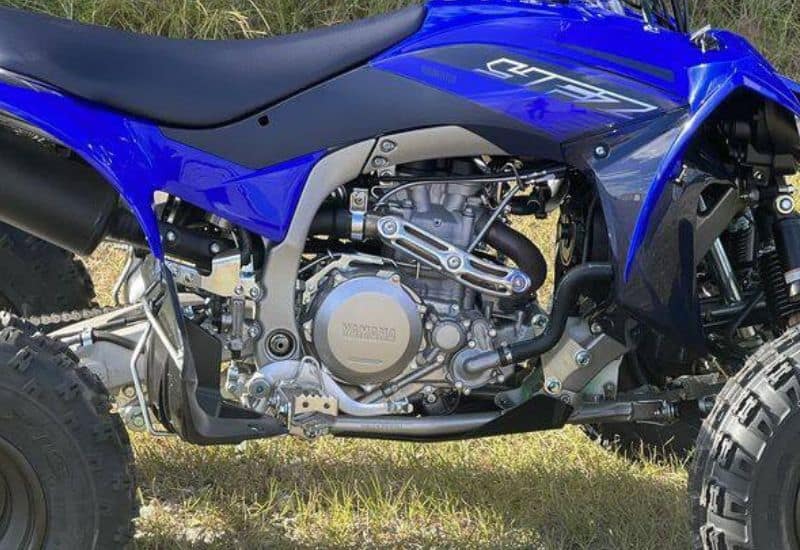
To better grasp real-world ATV power, here’s an overview of horsepower capacities often seen in various engine displacements.
50cc to 100cc Engines
Designed solely for youth riders, small 50 to 100cc powerplants allow pre-teens to develop operation skills without intimidating torque or unsafe speed.
Common in “transitional” models bridging from electric to gas.
Nearly all are fully automatic with horsepower ranging from 3 to 10 horsepower.
100cc to 300cc Engines
Still considered entry-level, teen and small adult rec-utility quads average 10-25 horsepower from their 100 to 300cc engines.
Modest power and torque provide adequate recreational trail ability for one rider. While still keeping the power on the lower end to ensure a safer and more manageable riding experience.
Features like automatic transmissions and electric start can often be found in this range, making them user-friendly for beginners.
300cc to 500cc Engines
ATVs with engine sizes ranging from 300 to 500cc are some of the most popular choices for beginner adults, looking for their first “starter” ATV.
Typically liquid-cooled four-stroke engines, these engine displacements generally crank out between 25 and 50 horsepower with conservative tuning.
This power range offers a solid balance between responsive acceleration and manageable control, making it an excellent step up from the lower cc classes without overwhelming new riders.
The increased horsepower also allows for more spirited trail riding, better handling, and a generally more robust riding experience.
500cc to 700cc Engines
500cc to 700cc engines are generally reserved for mid-size ATVs and designed for more experienced riders who want to do more aggressive trailer riding or need a more heavy-duty four-wheeler.
These larger engine displacements will typically produce power outputs ranging from 50 to 75 horsepower, depending on the engine setup and how it’s tuned.
The increased horsepower in this category means these ATVs have the muscle for demanding off-road activities, including higher-speed trail riding, more aggressive hill climbing, and navigating rough, uneven terrain with greater ease.
The power band is wider on these engines, allowing for quick acceleration and the ability to maintain higher speeds safely.
ATVs with 500 to 700cc engines come with more robust construction and often include reinforced frames, better suspension, and more durable drivetrains to handle the added power.
They can also tackle more serious work tasks, such as towing heavier trailers, carrying larger loads, and even plowing snow with the right attachment.
700cc to 1000cc Engines
The largest and most powerful class of ATVs offer engine displacements ranging from 700 to 1000cc, which allows them to produce anywhere from 75 to more than 90 horsepower.
These top-tier ATVs are engineered for extreme performance and can handle the most demanding riders and the toughest tasks.
They’re built with advanced technology and high-quality components to withstand intense use and deliver unparalleled power.
With horsepower figures that rival some small cars, ATVs in the 700cc to 1000cc range boast exceptional torque for deep mud, steep hills, and towing significant loads.
They’re often the preferred choice for extreme off-roading, competitive sports, or heavy-duty utility work where maximum power and ruggedness are required.
Pros & Cons of Different ATV Horsepower Levels
Engine output shapes the machine’s overall performance, but more horsepower isn’t necessarily better.
Lower horsepower quads are generally more affordable and easier to handle, while high horsepower machines deliver thrilling speed but require expert skills.
To help determine the ideal power for your next ATV, it’s essential to understand the pros and cons of more powerful and less powerful engines.
Weighing these pros and cons provides the sweet spot for you and your intended use and skill level.
Lower Horsepower ATV Pros:
- Easier to Control and Manage
- More Affordable to Buy and Run
- Simpler Maintenance
- Better Fuel Efficiency
Lower Horsepower ATV Cons:
- Underpowered for Larger Riders
- Less Hauling/Towing Ability
- Smaller Power Margin for Mistakes
Mid-Power ATV Pros:
- Balances Engine Output and Stability
- Confidence-inspiring Control
- Tows Moderate Loads Adequately
- Less Fatigue for Longer Rides
Mid-Power ATV Cons:
- Pushing Limits Risks Rollovers
- Hill Climbing Still Somewhat Limited
- Advanced Riders Will Find Acceleration Underwhelming
High-Horsepower ATV Pros:
- Thrill of Intense Acceleration
- Tow and Carry Heavy Loads With Ease
- Conquer Steep Grades and Hills
- Plenty of Capacity for Extra Rider and Accessories
High-Horsepower ATV Cons:
- Requires Advanced Riding Skills
- Greater Safety Risk if Mishandled
- Reduced Fuel Economy
- Cost Substantially More
- Can Cause Greater Fatigue if Riding Aggressively
Best Bolt-On Ways to Boost ATV Horsepower
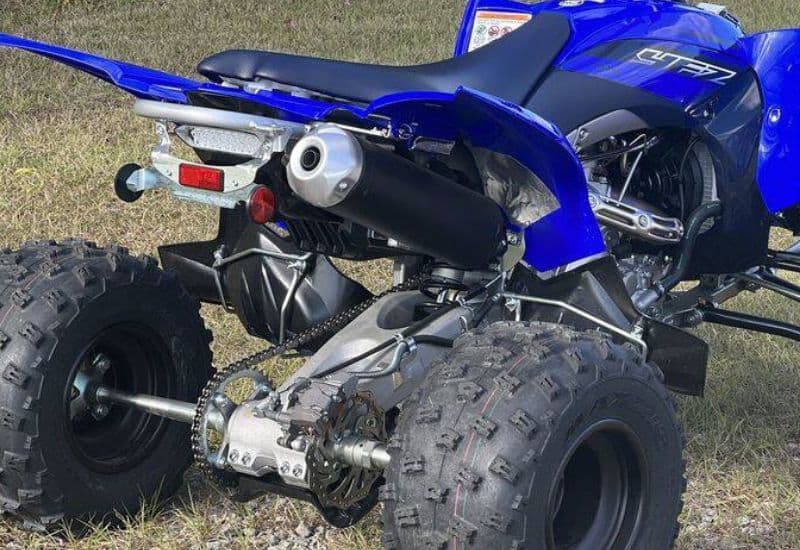
Even after buying an ATV, it’s possible to release more horses from the engine without fully rebuilding it.
Common bolt-on upgrades like these exchange parts for improved airflow and efficiency, which can add significant horsepower to your machine.
Aftermarket Air Filters
- Air filters protect the engine from dirt and dust while regulating airflow into the combustion chamber.
- Aftermarket filters use superior materials like cotton that allow more airflow compared to paper filters. This denser flow feeds the engine more oxygen for burning fuel and creating horsepower.
- Many aftermarket air filters simply drop into the stock housing, taking minutes to install. High-flow filters generally add 3 to 4 horsepower.
Aftermarket Exhaust Systems
- As combustion gases exit the cylinder, restrictive stock exhausts create backpressure that limits peak horsepower.
- Aftermarket slip-on mufflers significantly reduce this resistance using less baffling and larger tubing. Full high-performance systems will replace more components.
- Reduced backpressure allows the engine to breathe easier from idle to redline – extracting up to 8 plus extra horses. Keep in mind though, that increased exhaust performance also means a louder ATV, which may not work for some, depending on riding location.
Engine Control Units (ECU) & Fuel Controllers
- The ECU computer controls fueling, ignition timing, and other parameters based on sensor inputs.
- Piggyback devices and flash tuners intercept the ECU signals to lean out the fuel mixture and optimize timing across rpm ranges.
- Taking advantage of excess richness from emissions regulations, remapped ECUs generate more complete combustion for torque and horsepower boost up steep hills.
High-Performance Clutch Kits
- Clutch components like weights, ramps, and springs control when and how forcefully the belt engages to spin the gears as RPM rises and falls.
- Replacing stock parts with high-performance versions optimizes the clutch system for amplified and sustained power application.
- High-performance clutch kits have differently shaped flyweights, springs, and ramps that optimize clutch engagement positions as RPMs rise and fall.
- This keeps the engine in its ideal performance range longer, translating to noticeably crisper acceleration and higher sustained speeds – unleashing more usable power.
Used individually or combined, these simple bolt-on mods can add substantial mid-range and top-end horsepower to your ATV, by reducing restrictions and harnessing optimized airflow.
With just basic hand tools and a Saturday afternoon, enthusiast owners can give their average ATV anywhere from 10 to 20+ more horses!
More intensive options like engine blueprinting, aftermarket cams, head porting, and even turbocharger systems exist.
But for most recreational riders, basic airflow and exhaust improvements provide more than enough gains without breaking the bank.
Final Thoughts on ATV Horsepower
When choosing an all-terrain vehicle or four-wheeler, you should start by comparing horsepower ratings and other specs from one model to the next.
As this will allow you to eliminate models that are not a good fit and choose the best one for your particular needs.
However, don’t just assume that a higher horsepower rating is automatically better.
While it’s tempting to think more power is always best, that extra capability could prove dangerous if it exceeds your riding abilities.
Because of this, before choosing any four-wheeler or quad you should consider what you intend to use the ATV for and evaluate your riding skills realistically.
For example, if you’re a new rider who plans to do mostly light trail riding or light-duty work, you should stick with a machine with 50 horsepower or less.
If on the other hand, you’re an experienced ATV rider with years of riding under your belt, and you want to aggressively tear up the trails or need to do more heavy-duty work, then you should opt for an ATV with a horsepower rating of 50 or more.
Additional ATV Resources
For even more helpful information on ATVs, check out some of our other blog posts about ATVs.
- Do ATVs Have VIN Numbers? Decoding Vehicle Identification Numbers
- Are ATV Keys Universal? Everything You Need to Know
Recent Posts
In recent years, off-road enthusiasts have been taking their adventures to the next level by installing UTV underglow lights on their side-by-sides. Which adds a unique visual appeal and improves...
Side by sides, also known as UTVs, are used by a wide range of outdoor enthusiasts from off-roaders to farmers to ranchers, and hunters. As these versatile machines offer a unique blend of...
